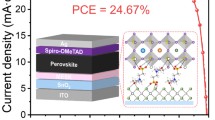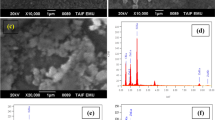Abstract
It is an important way to improve the efficiency of solar cells by using the special microstructures of surface. In this work, a pyramid–silicon nanowires (pyramid–SiNWs) binary structure was prepared on the silicon surfaces with the metal-assisted chemical etching (MACE) method. Scanning electron microscope (SEM) was used to observe the micromorphology of the pyramid–SiNWs binary structure. The formation mechanism of the binary structure was discussed. The role of Ag nanoparticles in MACE is considered to be the template and the catalyzer. The optical reflectivity of the silicon surfaces was studied with ultraviolet–visible (UV–Vis) spectrophotometer. Compared with the flat silicon surface and the simple pyramidal structure, the silicon surfaces with the pyramid–SiNWs binary structure achieve a much lower reflectance in a wide range of wavelength. The effect of etching time as a parameter on the reflectivity was also discussed.





Similar content being viewed by others
References
Beyer T, Tacke M. Antireflection coatings for PbSe diode lasers. Appl Phys Lett. 1998;73(15):2218.
Rajteri M, Rastello ML, Monticone E. Antireflection coatings for superconducting photodetectors. Nucl Instrum Methods Phys Rev. 2000;444(1–2):461.
Striemer CC, Fauchet PM. Dynamic etching of silicon for broadband antireflection applications. Appl Phys Lett. 2002;81(16):2980.
Deinega A, Valuev I, Potapkin B, Lozovik Y. Antireflective properties of pyramidally textured surfaces. Opt Lett. 2010;35(2):106.
Zhao JH, Wang AH, Green MA, Ferrazza F. 19.8% efficient ‘‘honeycomb’’ textured multicrystalline and 24.4% monocrystalline silicon solar cells. Appl Phys Lett. 1998;73(14):1991.
Koynov S, Brandt MS, Srutzmann M. Black non-reflecting silicon surfaces for solar cells. Appl Phys Lett. 2006;88(20):203107.
Peng KQ, Hu JJ, Yan YJ, Wu Y, Fang H, Xu Y, Lee ST, Zhu J. Fabrication of single-crystalline silicon nanowires by scratching a silicon surface with catalytic metal particles. Adv Funct Mater. 2006;16(3):387.
Peng KQ, Wang X, Lee ST. Silicon nanowire array photoelectrochemical solar cells. Appl Phys Lett. 2008;92(16):163103.
Zhang ML, Peng KQ, Fan X, Jie JS, Zhang RQ, Lee ST, Wong NB. Preparation of large-area uniform silicon nanowires arrays through metal-assisted chemical etching. J Phys Chem C. 2008;112(12):4444.
Sun XZ, Lin LH, Li ZC, Zhang ZJ, Feng JY. Fabrication of silver-coated silicon nanowire arrays for surface-enhanced Raman scattering by galvanic displacement processes. Appl Surf Sci. 2009;256(3):916.
Zhang BH, Wang HS, Lu LH, Ai KL, Zhang G, Cheng XL. Large-area silver-coated silicon nanowire arrays for molecular sensing using surface-enhanced Raman spectroscopy. Adv Funct Mater. 2008;18(16):2348.
Peng KQ, Yan YJ, Gao SP, Zhu J. Synthesis of large-area silicon nanowire arrays via self-assembling nanoelectrochemistry. Adv Mater. 2002;14(16):1164.
Peng KQ, Wu Y, Fang H, Hu JJ, Wu Y, Zhu J, Yan YJ, Lee S. Metal-particle-induced, highly localized site-specific etching of Si and formation of single-crystalline Si nanowires in aqueous fluoride solution. Chem Eur J. 2006;12(30):7942.
Peng KQ, Wu Y, Fang H, Zhong XY, Xu Y, Zhu J. Uniform axial-orientation alignment of one-dimensional single-crystal silicon nanostructure arrays. Angew Chem Int Ed. 2005;44(18):2737.
Peng KQ, Lu AJ, Zhang RQ, Lee ST. Motility of metal nanoparticles in silicon and induced anisotropic silicon etching. Adv Funct Mater. 2008;18(19):3026.
Acknowledgments
This work was financially supported by the National Natural Science Foundation of China (Nos. 51032002 and 11274028).
Author information
Authors and Affiliations
Corresponding author
Rights and permissions
About this article
Cite this article
Zhang, ZL., Wang, B., Chen, Y. et al. Preparation of pyramid–SiNWs binary structure with Ag nanoparticles-assisted chemical etching. Rare Met. 38, 312–315 (2019). https://doi.org/10.1007/s12598-015-0608-0
Received:
Revised:
Accepted:
Published:
Issue Date:
DOI: https://doi.org/10.1007/s12598-015-0608-0




